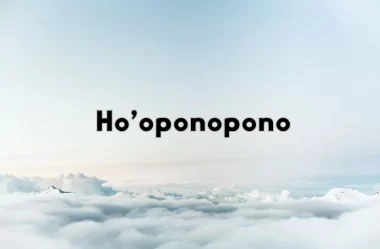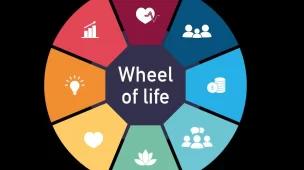Ho’oponopono is a traditional Hawaiian practice of reconciliation and forgiveness. It involves a process of healing that focuses on resolving conflicts and disharmonies within oneself. Also with others, and with the environment. Based on the understanding that everything in the universe is interconnected.
What are the ways to practice?
The practice has been adapted in various ways outside of Hawaiian culture. Often focusing on the individual’s role in healing themselves. Their relationships are built on love, forgiveness, repentance, and gratitude.
Is there a modern example of Ho’oponopono’s power?
The most famous modern example of Ho’oponopono’s power is often associated with Dr. Ihaleakala Hew Len.
What is the story about?
Dr. Hew Len, a Hawaiian psychologist, reportedly used the Ho’oponopono process to heal an entire ward criminally. Patients at the Hawaii State Hospital between 1984 and 1987, without having direct interaction with them.
According to the stories, he reviewed the patients’ files and then worked on himself. Using the Ho’oponopono mantra to cleanse his perceptions, thoughts, and feelings about each patient. The mantra consists of four simple phrases:
- I’m sorry.
- Please forgive me.
- Thank you.
- I love you.
Dr. Hew Len’s approach was based on the principle that by healing himself, he could heal others.
The story goes that as he continued this inner work.
The patients began to heal, as evidenced by their improved behaviour.
The closure of the ward was due to the patients being released as healed.
It has become a powerful example in self-help and alternative healing circles to illustrate the potential of Ho’oponopono.
The concept is that taking responsibility for one’s state can lead to healing in others.
This example serves to highlight the core belief of Ho’oponopono: that everything is in our reality. It is a reflection of our inner state. By healing ourselves, we can indirectly heal our relationships and our world. It’s a practice that emphasizes love, responsibility, and the power of forgiveness. Not just toward others but, more importantly, towards oneself.
Master Authentic Ho’oponopono Click Here
The Heart of Healing
At its essence, ho’oponopono is a deeply spiritual practice that champions taking ownership of one’s actions and emotions. It encourages individuals to delve into their innermost thoughts and feelings, facing them with courage and compassion. By acknowledging our role in creating disharmony or pain. We open ourselves up to the transformative power of forgiveness and reconciliation.
This art of healing goes beyond surface-level apologies. It delves into the depths of our being. Seeking to mend not only visible wounds but also those concealed within our hearts. In embracing ho’oponopono, we embrace a path toward inner peace, harmony with others, and ultimately, spiritual growth.
The Heart of Healing: Ho’oponopono’s Origin in Hawaii
In the lush, tropical paradise of Hawaii. Amidst the gentle rustling of palm trees and the soothing sounds of ocean waves. This profound practice known as ho’oponopono has flourished for centuries. This ancient Hawaiian tradition embodies the essence of forgiveness. Also healing, and reconciliation, are rooted deeply in the cultural fabric of the islands. The word “ho’oponopono” itself carries a weighty significance, translating to “to make a right” or “to rectify an error.” It reflects the core belief that harmony within oneself and with others is essential for well-being.
The origins of ho’oponopono can be traced back to indigenous Hawaiian. Practices that sought to resolve conflicts and restore balance within communities. It was traditionally conducted by a kahuna (a spiritual leader or healer). He facilitated a process of dialogue, confession, forgiveness, and resolution among individuals or groups.
This sacred ritual was seen as a way to purify relationships, release negative energy, and promote inner peace. As ho’oponopono has gained global recognition in modern times, its foundational principles remain deeply intertwined with Hawaiian culture and spirituality.
Master Authentic Ho’oponopono Click Here
Mending Broken Bonds: The Meaning Behind Ho’oponopono
At its core, ho’oponopono encapsulates a profound understanding of human nature and interconnectedness. The essence of this practice lies in recognizing our inherent capacity for causing harm and facilitating healing.
By acknowledging our mistakes and shortcomings with humility and sincerity. We open ourselves up to the transformative power of forgiveness and reconciliation. The concept of “making things right” goes beyond mere words. It requires a genuine commitment to taking responsibility for our actions and their impact on others.
In the context of ho’oponopono, making amends is not just about seeking external validation or absolution. It is about cultivating a deep sense of inner harmony. It involves delving into the depths of our consciousness to confront our fears, regrets, and emotional wounds.
Through this process of self-reflection and self-forgiveness, we begin to unravel the layers of hurt that have accumulated over time. Ho’oponopono invites us to embrace vulnerability. As a pathway to healing – both individually and collectively. Paving the way for greater compassion and understanding in our relationships with others.
Embracing Responsibility: A Fundamental Principle
In the realm of Ho’oponopono, the cornerstone principle revolves around the profound act of taking full responsibility for one’s actions. This isn’t merely about acknowledging when mistakes have been made. It’s about recognizing that our thoughts and intentions hold immense power in shaping our reality.
By accepting responsibility for our thoughts and actions. We reclaim agency over our lives and empower ourselves to effect positive change. It’s a transformative process that requires courage and humility. It necessitates a willingness to confront both our light and shadow aspects.
Forgiveness and Reconciliation: Pathways to Healing
Central to the practice of Ho’oponopono is the art of forgiveness and reconciliation. Through this ancient Hawaiian tradition, individuals are encouraged to release grudges, resentments, and grievances that weigh heavy on the heart. Forgiveness is not an act condoning past wrongs. It is a liberating choice to let go of negative emotions that bind us to suffering.
By extending forgiveness – both towards others and ourselves – we open the door to profound healing at a soul level. This process of reconciliation paves the way for inner peace and fosters. Harmonious relationships with those around us, create a ripple effect of positivity in our lives.
The Four Key Phrases of Ho’oponopono
“I’m Sorry”: Healing Through Humility
In the practice of Ho’oponopono, the phrase “I’m sorry” holds immense transformative power. By expressing genuine remorse for past actions, words, or thoughts that have contributed to disharmony within oneself or with others, one takes the first step towards healing.
This phrase is not a mere formality but a profound acknowledgment of one’s imperfections and willingness to seek forgiveness. Saying “I’m sorry” in Ho’oponopono is an act of humility that paves the way for self-forgiveness and reconciliation.
“Please Forgive Me”: The Art of Seeking Redemption
“Please forgive me” is a plea for redemption and a request for release from the burdens of guilt and regret. In Ho’oponopono, this phrase signifies a deep understanding of the interconnectedness of all beings and the recognition that our actions can have unintended consequences on others.
By uttering these words with sincerity and vulnerability, one opens their heart to the possibility of forgiveness both from others and from oneself. It symbolizes a willingness to let go of past grievances and start anew with a clean slate.
Master Authentic Ho’oponopono Click Here
Exploring the Practice of Ho’oponopono
Self-Reflection and Introspection
In the practice of Ho’oponopono, self-reflection, and introspection play a crucial role in healing and reconciliation. It involves looking inward, and examining our thoughts, emotions, and beliefs to identify areas that need healing or forgiveness.
This process requires honesty with oneself and acknowledging any negative patterns or behaviors that may be causing disharmony in our lives. By reflecting on our actions and intentions, we can take ownership of our mistakes and begin the journey towards self-improvement.
Repeating the Four Key Phrases as a Mantra
Central to the practice of Ho’oponopono are four key phrases: “I’m sorry,” “Please forgive me,” “Thank you,” and “I love you.” These phrases are repeated as a mantra, either silently or aloud, to cultivate a mindset of forgiveness, gratitude, and love.
The act of saying “thank you” acknowledges the opportunity for growth through challenges, while expressing love helps us connect with others on a deeper level. This repetitive practice serves as a powerful tool for transforming negative energy into positive vibrations.
Clearing Negative Emotions and Memories
Another essential aspect of practising Ho’oponopono is clearing negative emotions and memories that may be holding us back from living authentically. By confronting unresolved conflicts or past traumas through the four key phrases, we can release emotional baggage that weighs us down.
Master Authentic Ho’oponopono Click Here
Benefits of Ho’oponopono
Stress Reduction and Emotional Healing
When it comes to dealing with stress and emotional baggage, ho’oponopono is like a soothing balm for the weary soul. By practising this ancient Hawaiian technique, individuals can release pent-up emotions, grievances, and anxieties that weigh heavy on their hearts. The act of sincerely apologizing, seeking forgiveness, expressing gratitude, and offering love helps to untangle the knots of negativity within oneself.
This process not only frees the mind from unnecessary burdens but also allows for a deep sense of relief and catharsis. Through ho’oponopono, one can experience a profound sense of emotional healing and inner peace that reverberates through every fibre of their being.
Improved Relationships with Others
In our interconnected world, relationships play a crucial role in shaping our experiences and well-being. Ho’oponopono offers a unique pathway to mend broken relationships, cultivate understanding, and foster empathy towards others.
By acknowledging one’s role in conflicts or misunderstandings through the practice of apologizing and seeking forgiveness sincerely, individuals can pave the way for reconciliation and healing in their relationships. The power of gratitude and love embedded within ho’oponopono is a bridge to connect hearts that were once estranged.
As people engage in this practice authentically, they often find that their interactions with others become more harmonious, compassionate, and fulfilling. Through ho’oponopono, individuals can nurture genuine connections based on mutual respect and understanding.
Revolutionizing Therapy and Counseling
Ho’oponopono has found its way into modern therapy and counselling practices, offering a unique approach to healing and reconciliation. Therapists and counsellors are integrating the principles of ho’oponopono to help clients address past traumas, release negative emotions, and cultivate forgiveness. By encouraging individuals to take responsibility for their actions and thoughts, ho’oponopono promotes self-reflection and personal growth within therapeutic settings.
This ancient Hawaiian practice provides a framework for individuals to work through their emotional baggage, leading to a greater sense of inner peace and well-being. Therapists who incorporate ho’oponopono techniques often witness profound transformations in their clients as they navigate the journey towards forgiveness and self-acceptance.
Fostering Harmony Through Conflict Resolution
Ho’oponopono’s emphasis on reconciliation makes it a valuable tool in conflict resolution and mediation processes. Whether resolving disputes in personal relationships or navigating conflicts in professional settings, the practice of ho’oponopono can facilitate healing conversations and promote understanding between the parties involved. By encouraging individuals to express remorse, seek forgiveness, express gratitude, and show love towards one another, ho’oponopono paves the way for peaceful resolutions.
This Hawaiian art of healing offers a holistic approach to conflict resolution by addressing not only the external issues but also the internal wounds that contribute to discord. Through practising ho’oponopono, individuals learn how to let go of resentments, communicate effectively, and foster genuine connections based on mutual respect.
Elevating Personal Growth as a Tool for Self-Improvement
Beyond its applications in therapy and conflict resolution, ho’oponopono serves as a powerful personal development tool for self-improvement. Individuals who embrace the practice of ho’ opono pono commit themselves to ongoing self-reflection, emotional healing, and inner transformation.
By incorporating the four key phrases into their daily lives—”I’m”sorry,” “Please forgive me,” “Thank you,” and “I love”you”—practicers of ho’ opono pono cultivate a mindset rooted in compassion, gratitude, and love. Through consistent practice of ho’ opono pono as a form of meditation or mantra repetition, individuals can clear limiting beliefs, release negative emotions, and enhance their overall well-being.
As they embark on this journey towards self-discovery, many find that ho’oponopono unlocks hidden potential, fosters resilience,and empowers them to live authentically. In essence, ho ‘ opono bono becomes not just a practice but a way of being that promotes growth at all levels—emotionally, spiritually, mentally, and physically.
Cultural Appropriation Concerns
One of the main criticisms surrounding Ho’oponopono is the issue of cultural appropriation. Some argue that the widespread adoption of this traditional Hawaiian practice by individuals outside of the Hawaiian culture is disrespectful and diminishes its sacred significance. Critics point out that Western interpretations of Ho’oponopono may oversimplify or distort its original purpose, stripping away its cultural context and significance.
This raises concerns about the commodification and commercialization of a spiritual practice deeply rooted in Hawaiian traditions. Moreover, there is a valid concern about misrepresentation and exploitation when non-Hawaiians claim expertise in Ho’oponopono without fully understanding or respecting its cultural origins.
It’s essential to approach this practice with sensitivity, acknowledging its roots in Hawaiian culture and history. By honoring and preserving the integrity of Ho’oponopono within its cultural context, we can respect its traditions and values while benefiting from its healing principles.
Lack of Scientific Evidence to Support Its Effectiveness
Another point of contention surrounding Ho’oponopono is the lack of scientific evidence to validate its effectiveness as a healing practice. Skeptics argue that the anecdotal success stories associated with Ho’oponopono are not sufficient to establish it as a scientifically proven method for emotional healing or reconciliation.
Without empirical studies or clinical trials demonstrating measurable outcomes, some question the credibility and legitimacy of this ancient Hawaiian tradition as a therapeutic tool. While proponents of Ho’oponopono emphasize personal experiences and spiritual insights as evidence of its efficacy, the absence of empirical research leaves room for doubt among sceptics.
The challenge lies in bridging traditional wisdom with modern scientific standards to provide a more comprehensive understanding of how Ho’oponopono works on a psychological and physiological level. As research into alternative healing practices continues to evolve, addressing these gaps in knowledge will be crucial in determining the true impact and effectiveness of Ho’oponopono.
Misinterpretation or Oversimplification by Some Practitioners
Without proper guidance from experienced practitioners or mentors well-versed in Hawaiian culture, novices might struggle to grasp the profound depth and subtlety required for effective application. By recognizing these risks and pitfalls associated with misinterpretation or oversimplification, practitioners can cultivate a deeper understanding.
Embracing Forgiveness, Healing, and Reconciliation
Forgiveness is a transformative power that can free us from the burdens of anger, resentment, and pain. In the practice of Ho’oponopono, we learn to embrace forgiveness not only for others but also for ourselves. By acknowledging our mistakes, seeking forgiveness, expressing gratitude, and nurturing love within our hearts, we pave the way for healing and reconciliation in our lives.
Ho’oponopono teaches us that true healing comes from within. When we take responsibility for our actions and emotions, we reclaim our power to create positive change in ourselves and our relationships.
Through the simple yet profound practice of repeating the four key phrases – “I’m sorry,” “Please forgive me,” “Thank you,” and “I love you” – we open ourselves up to a deeper level of self-awareness and compassion. This inner work not only benefits us individually but also ripples out into the world around us.
Empowering You to Embrace Ho’oponopono
As you embark on your journey with Ho’oponopono, remember that you hold the key to your healing and transformation. By integrating this ancient Hawaiian practice into your daily life, you have the opportunity to cultivate a greater sense of peace, harmony, and well-being.
By nurturing these seeds with intention and mindfulness, you are nurturing a garden of forgiveness and love that will flourish over time. Embrace Ho’oponopono not as a quick fix but as a powerful tool for personal growth and evolution.
Allow its wisdom to guide you towards greater understanding, compassion, and unity within yourself and with others. Trust in the process, have faith in your journey.
Master Authentic Ho’oponopono Click Here
Further Insights and Articles Related to Ho’oponopono
Related posts:
No related posts.








